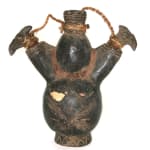Grasslands Terracotta Vessel with Three Spouts and Two Bird-Headed Stoppers, 20th Century CE
Terracotta
MT.303 (LSO)
This impressive three-spouted ceramic vessel appears to have been made by one of the numerous Grasslands groups of Cameroon, including the Bamileke and Bamun. It is a simple globular form,...
This impressive three-spouted ceramic vessel appears to have been made by one of the numerous Grasslands groups of Cameroon, including the Bamileke and Bamun. It is a simple globular form, with an incised decoration pedestal base. The ground is undecorated, except for a floreate pattern on the midsection of the main body of the vessel. The central, rounded spout and the body have been formed into the likeness of a woman’s body, with incised/relief breasts and curvilinear forms; the central spout is surmounted with a vaguely head-shaped eminence decorated with incised designs. The two other spouts are much more rectilinear. These are stopped with plugs made in the likeness of birds’ heads, which are in turn tied to the central spout with lengths of raffia twine.
The Grasslands contains numerous small, quasi- independent kingdoms, notably the Bamileke, the Bamenda-Tikar and the Bamum. The king/fon/leader of the group and his courtly associates are equipped with regalia and prestige objects, leading to a proliferation of craftsmen and artists who occupied valuable social roles within the community. Even secular objects are decorated with characteristically Grasslands iconography, although function cannot always be ascertained, as in the current case.
Given the peculiar nature of its construction it is likely to have occupied a supra-secular function, perhaps for administering libations or sharing valuable liquids such as wine. Whatever its purpose, it is an attractive and impressive piece of African art.
The Grasslands contains numerous small, quasi- independent kingdoms, notably the Bamileke, the Bamenda-Tikar and the Bamum. The king/fon/leader of the group and his courtly associates are equipped with regalia and prestige objects, leading to a proliferation of craftsmen and artists who occupied valuable social roles within the community. Even secular objects are decorated with characteristically Grasslands iconography, although function cannot always be ascertained, as in the current case.
Given the peculiar nature of its construction it is likely to have occupied a supra-secular function, perhaps for administering libations or sharing valuable liquids such as wine. Whatever its purpose, it is an attractive and impressive piece of African art.



